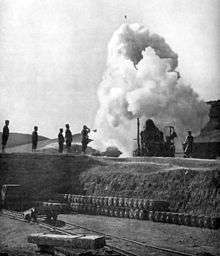Third Army (Japan)
| Japanese Third Army | |
|---|---|
 IJA 3rd Army at Port Arthur, 1904 | |
| Active | May 1904-Aug 1945 |
| Country | Empire of Japan |
| Branch | Imperial Japanese Army |
| Type | Infantry |
| Role | Corps |
| Garrison/HQ | Yanji, Manchukuo |
| Nickname(s) | Iwa (岩 rock) |
| Engagements |
Russo-Japanese War Soviet invasion of Manchuria |
The Japanese 3rd Army (第3軍 Dai-san gun) was an army of the Imperial Japanese Army based in Manchukuo as a garrison force under the overall command of the Kwantung Army during World War II, but its history dates to the Russo-Japanese War.
History
The Japanese 3rd Army was initially raised during the Russo-Japanese War under the command of General Nogi Maresuke. In the initial stages of the war, its primary mission was the Siege of Port Arthur. After the fall of that Russian stronghold, it was transferred north, where it played a crucial role in the subsequent Japanese drive towards Mukden in the closing stages of the war. It was disbanded at the end of the war.
The Japanese 3rd Army was raised again on January 13, 1938 in Manchukuo as a garrison force to guard the eastern borders against possible incursions by the Soviet Red Army. It afterwards came under the command of the Japanese First Area Army in July 1942. As the war situation deteriorated for the Japanese in southeast Asia, the more experienced units and much of the equipment of the IJA 3rd Army were transferred to other units.
During the Soviet invasion of Manchuria, its poorly trained and under-equipped forces were no match for the experienced battle-hardened Soviet Army, and it was forced back from various locations in Kirin province to the Korean border, surrendering at the end of the war in Yanji and Hunchun, in what is now part of the Yanbian Korean Autonomous Prefecture of northeast China.
List of commanders
Commanding officer
| Name | From | To | |
|---|---|---|---|
| 1 | General Nogi Maresuke | August 1904 | January 1906 |
| 2 | General Otozō Yamada | 13 January 1938 | 10 December 1938 |
| 3 | General Hayao Tada | 10 December 1938 | 12 September 1939 |
| 4 | General Kamezo Suetaka | 12 September 1939 | 1 March 1941 |
| 5 | General Masakazu Kawabe | 1 March 1941 | 17 August 1942 |
| 6 | Lieutenant General Eitaro Uchiyama | 17 August 1942 | 7 February 1944 |
| 7 | Lieutenant General Hiroshi Nemoto | 7 February 1944 | 22 November 1944 |
| 8 | Lieutenant General Murakami Keisaku | 22 November 1944 | September 1945 |
Chief of Staff
| Name | From | To | |
|---|---|---|---|
| 1 | Major General Ijichi Kōsuke | August 1904 | January 1905 |
| 2 | Major General Masatoshi Matsunaga | February 1905 | March 1905 |
| 3 | Major General Ichinohe Hyoe | March 1905 | January 1906 |
| 4 | Lieutenant General Aketo Nakamura | 20 January 1938 | 14 April 1938 |
| 5 | Lieutenant General Teiichi Suzuki | 14 April 1938 | 10 December 1938 |
| 6 | Lieutenant General Masami Maeda | 10 December 1938 | 9 March 1940 |
| 7 | Lieutenant General Toshimichi Uemura | 9 March 1940 | 1 April 1941 |
| 8 | Lieutenant General Takezo Numata | 1 April 1941 | 1 July 1942 |
| 9 | Major General Akio Doi | 1 July 1942 | 11 March 1943 |
| 10 | Major General Tatsuhiko Takashima | 11 March 1943 | 16 December 1944 |
| 11 | Major General Hanjiro Ikeya | 16 December 1944 | September 1945 |
References
- Frank, Richard B (1999). Downfall: The End of the Imperial Japanese Empire. New York: Random House. ISBN 0-679-41424-X.
- Jowett, Bernard (1999). The Japanese Army 1931-45 (Volume 2, 1942-45). Osprey Publishing. ISBN 1-84176-354-3.
- Madej, Victor (1981). Japanese Armed Forces Order of Battle, 1937-1945. Game Publishing Company. ASIN: B000L4CYWW.
- Marston, Daniel (2005). The Pacific War Companion: From Pearl Harbor to Hiroshima. Osprey Publishing. ISBN 1-84176-882-0.
- Glantz, David (2003). The Soviet Strategic Offensive in Manchuria, 1945 (Cass Series on Soviet (Russian) Military Experience, 7). Routledge. ISBN 0-7146-5279-2.
External links
- Lt. Col. David Glantz, August Storm: The Soviet 1945 Strategic Offensive in Manchuria, Leavenworth Paper No.7, Command and General Staff College, February 1983.
- Wendel, Marcus. "Axis History Factbook". Japanese 3rd Army.